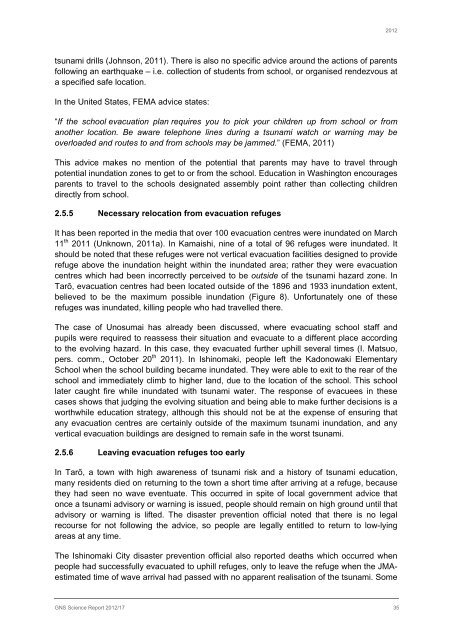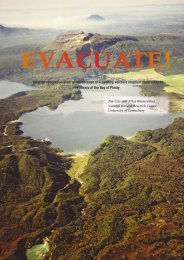Tsunami evacuation: Lessons from the Great East Japan earthquake ...
Tsunami evacuation: Lessons from the Great East Japan earthquake ...
Tsunami evacuation: Lessons from the Great East Japan earthquake ...
Create successful ePaper yourself
Turn your PDF publications into a flip-book with our unique Google optimized e-Paper software.
2012<br />
tsunami drills (Johnson, 2011). There is also no specific advice around <strong>the</strong> actions of parents<br />
following an <strong>earthquake</strong> – i.e. collection of students <strong>from</strong> school, or organised rendezvous at<br />
a specified safe location.<br />
In <strong>the</strong> United States, FEMA advice states:<br />
“If <strong>the</strong> school <strong>evacuation</strong> plan requires you to pick your children up <strong>from</strong> school or <strong>from</strong><br />
ano<strong>the</strong>r location. Be aware telephone lines during a tsunami watch or warning may be<br />
overloaded and routes to and <strong>from</strong> schools may be jammed.” (FEMA, 2011)<br />
This advice makes no mention of <strong>the</strong> potential that parents may have to travel through<br />
potential inundation zones to get to or <strong>from</strong> <strong>the</strong> school. Education in Washington encourages<br />
parents to travel to <strong>the</strong> schools designated assembly point ra<strong>the</strong>r than collecting children<br />
directly <strong>from</strong> school.<br />
2.5.5 Necessary relocation <strong>from</strong> <strong>evacuation</strong> refuges<br />
It has been reported in <strong>the</strong> media that over 100 <strong>evacuation</strong> centres were inundated on March<br />
11 th 2011 (Unknown, 2011a). In Kamaishi, nine of a total of 96 refuges were inundated. It<br />
should be noted that <strong>the</strong>se refuges were not vertical <strong>evacuation</strong> facilities designed to provide<br />
refuge above <strong>the</strong> inundation height within <strong>the</strong> inundated area; ra<strong>the</strong>r <strong>the</strong>y were <strong>evacuation</strong><br />
centres which had been incorrectly perceived to be outside of <strong>the</strong> tsunami hazard zone. In<br />
Tarō, <strong>evacuation</strong> centres had been located outside of <strong>the</strong> 1896 and 1933 inundation extent,<br />
believed to be <strong>the</strong> maximum possible inundation (Figure 8). Unfortunately one of <strong>the</strong>se<br />
refuges was inundated, killing people who had travelled <strong>the</strong>re.<br />
The case of Unosumai has already been discussed, where evacuating school staff and<br />
pupils were required to reassess <strong>the</strong>ir situation and evacuate to a different place according<br />
to <strong>the</strong> evolving hazard. In this case, <strong>the</strong>y evacuated fur<strong>the</strong>r uphill several times (I. Matsuo,<br />
pers. comm., October 20 th 2011). In Ishinomaki, people left <strong>the</strong> Kadonowaki Elementary<br />
School when <strong>the</strong> school building became inundated. They were able to exit to <strong>the</strong> rear of <strong>the</strong><br />
school and immediately climb to higher land, due to <strong>the</strong> location of <strong>the</strong> school. This school<br />
later caught fire while inundated with tsunami water. The response of evacuees in <strong>the</strong>se<br />
cases shows that judging <strong>the</strong> evolving situation and being able to make fur<strong>the</strong>r decisions is a<br />
worthwhile education strategy, although this should not be at <strong>the</strong> expense of ensuring that<br />
any <strong>evacuation</strong> centres are certainly outside of <strong>the</strong> maximum tsunami inundation, and any<br />
vertical <strong>evacuation</strong> buildings are designed to remain safe in <strong>the</strong> worst tsunami.<br />
2.5.6 Leaving <strong>evacuation</strong> refuges too early<br />
In Tarō, a town with high awareness of tsunami risk and a history of tsunami education,<br />
many residents died on returning to <strong>the</strong> town a short time after arriving at a refuge, because<br />
<strong>the</strong>y had seen no wave eventuate. This occurred in spite of local government advice that<br />
once a tsunami advisory or warning is issued, people should remain on high ground until that<br />
advisory or warning is lifted. The disaster prevention official noted that <strong>the</strong>re is no legal<br />
recourse for not following <strong>the</strong> advice, so people are legally entitled to return to low-lying<br />
areas at any time.<br />
The Ishinomaki City disaster prevention official also reported deaths which occurred when<br />
people had successfully evacuated to uphill refuges, only to leave <strong>the</strong> refuge when <strong>the</strong> JMAestimated<br />
time of wave arrival had passed with no apparent realisation of <strong>the</strong> tsunami. Some<br />
GNS Science Report 2012/17 35

















